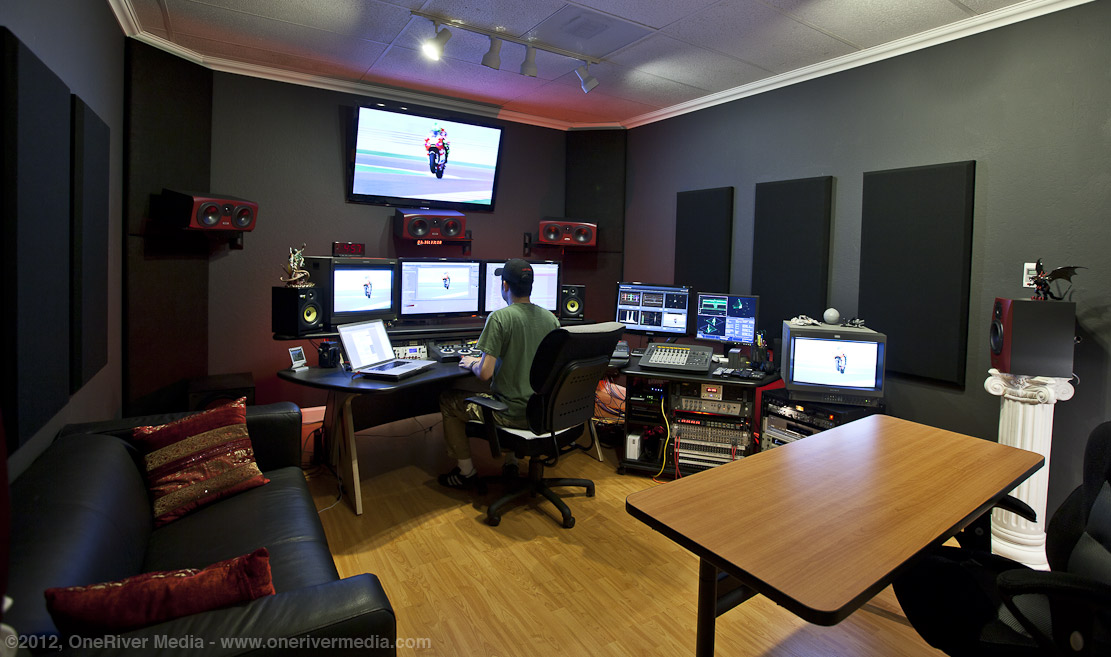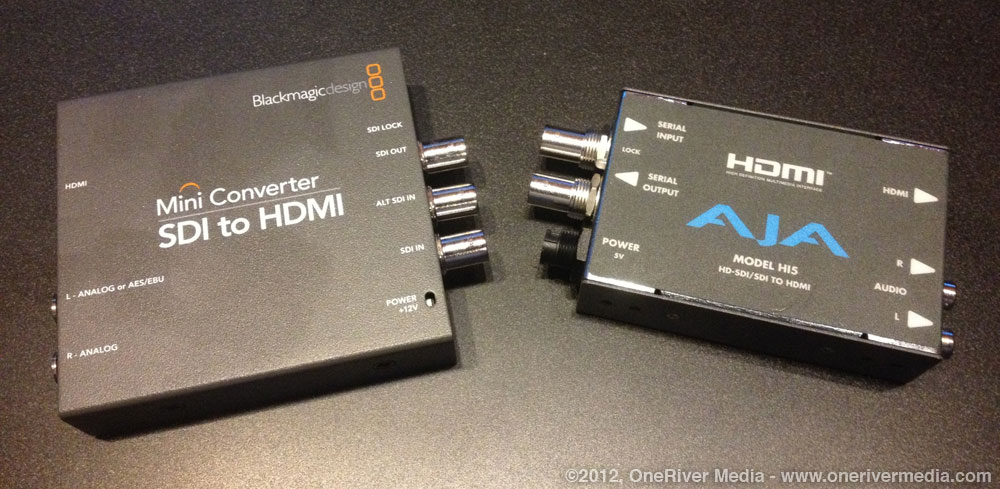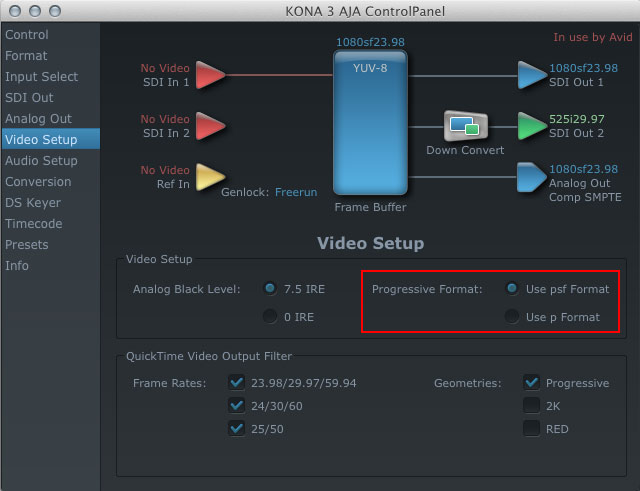With our recent conversion to AVID Symphony 6 on OSX Lion from Final Cut Pro 7, I ran into a little snag with client monitor output that is finally solved. Hopefully this will help save some time on your end too.
The setup is pretty simple. Our master edit suite MacPro workstation houses an AJA Kona card that then outputs its main HD-SDI spigot to three main destinations; a Sony PVM-20L5 CRT monitor, a Samsung 55” LED client monitor, and a Blackmagic Design Ultrascope (the Kona’s secondary HD-SDI output is down-rezed to NTSC SD to a Tektronix WVR-610A rastering waveform vectorscope, and a Sony PVM-20S1WU 16×9 CRT secondary client monitor. Yes, the client has two client monitors… what can I say, I like to spoil them).

Here in our master edit suite with so many display types, there's bound to be a snag at some point with compatibility. That snag came and has been fixed.
The 55” LED client monitor is consumer based, so it requires an SDI-to-HDMI converter. Being the big AJA fan that I am, I bought an AJA Hi5 converter for just this task a few years back. Worked great, except that I always got an “incompatible source” error on the Samsung if I tried running in native 24p. Figuring it was the display’s fault, I always had the Kona output set to 60i so that the Kona would in turn perform a real-time 2:3 pulldown insertion from the timeline’s 24p source.
So for years, this has worked great in Final Cut Pro. But fast-forward to now with our AVID Symphony conversion, and welcome an old problem become new again.
The “problem” is that AVID Symphony only allows real-time 2:3 pulldown conversion using its own Nitris DX hardware, even though the AJA Kona hardware is more than capable of performing this task on its own. I actually would have been willing to buy Nitris DX hardware (which is actually AJA hardware!), but the problem is that it’s a bit of a desert island; it doesn’t work with a multitude of other software solutions including Adobe After Effects. Alternatively with the Kona card, I can use it in Avid, Final Cut Pro, Premiere, After Effects, Smoke, Color, just about everything except for Resolve (but that’s another peeve for another day).
So that means Nitris DX hardware is out of the picture. I need to get this output to work with 24p sequences as that’s 99% of all our work these days.
As mentioned, I thought it was my Samsung display that caused the 24p source error, so I routed the Kona output from the machine room to our conference room where we have a similar LG 55” LED monitor in there. Looking at the LG’s product literature, it specifically said it displayed 24p material. I was hopefully that it would work, even though it might have meant needing to swap 55” displays… not a fun task.
It turns out the LG display didn’t work either. I then researched the differences between the AJA Hi5 SDI-to-HDMI converter and the Blackmagic Design SDI-to-HDMI converter. Turns out the AJA Hi5 doesn’t perform 23.976pfs output (only straight 23.976p and 24p). What?!! Interestingly, I also read that the BMD converter does 23.976pfs, but not straight 23.976p and 24p. Wanting to so if the BMD converter would do the trick, I ordered one for over-night delivery.

Two SDI-to-HDMI converters, two slightly different results.
So here I am today and UPS delivered the BMD SDI-to-HDMI converter. In both AVID Symphony and Final Cut Pro, the BMD converter actually ended up playing all 24p formats (24p, 23.976p, and 23.976pfs), despite what some sources about the BMD product mentioned. Success! This was really great to see, even though it broke my heart a little that the AJA Hi5 converter does not perform 23.976pfs. Note that my Hi5 converter is a couple of years old, so there’s a chance that AJA may have updated this product since then. The “problem” though is that the AJA box doesn’t have a USB port on it like the BMD converter does, so any updating to the AJA unit would require it being sent back to AJA, whereas the BMD unit can be upgraded on your own thanks to the USB port.
And for what it’s worth, the Kona Control Panel doesn’t seem to output a change for Symphony when you change the 24p format from “pfs” to “p”, so that didn’t help the AJA Hi5 unit to work.

Unfortunately changing the progressive format from “psf” to “p” (outlined in the red box) didn’t allow the AJA Hi5 converter to function properly.
Here’s the breakdown in 24p output compatibility from both SDI-to-HDMI devices:
AJA Hi5 – 24p (yes), 23.976p (yes), 23.976pfs (no)
BMD – 24p (yes), 23.976p (yes), 23.976pfs (yes)
So in short, if you want to run native 24p output from your AVID Media Composer or Symphony set up (under version 6) with your third party output hardware, then you’ll probably be better off getting a Blackmagic Design SDI-to-HDMI converter for those consumer LCD/LED/plasma monitors. This will allow you to run in native 24p without 2:3 pulldown insertion.
So I’m glad to say that all my monitors, professional and consumer, can once again play back all formats I throw at it under AVID Symphony using my AJA Kona hardware. This is a relief and only cost me $300 to fix.
EDIT May 15, 2012: Unbeknownst to me, it appears the AJA Hi5 unit I’ve used all this time is an early version, mainly due to the fact that the most recent versions of the Hi5 does in fact have a USB port on one end (unlike mine) for updating firmware. Although I do not have a newer version Hi5 (3G or 3D) to test my scenario on for verification, Michael Kammes did tell me that he is able to output standard 23.976p from a Nitris DX 23.976pfs output using the newer Hi5 3G model. I’d assume the same would be true when using AJA Kona hardware for output as well as is the case in my scenario. So final food for thought: either get a new USB-based AJA Hi5 (3G or 3D), or get a Blackmagic Design SDI to HDMI converter counterpart. In other words… DON’T get the older non-USB AJA Hi5 like I’ve been using!
Share this post
Article © OneRiver Media, including applicable photographs. All rights reserved. Article and its contents shall not be copied or reprinted without the expressed written approval of OneRiver Media.
FCC Disclaimer - Links from this article might go to affiliate links to B&H and/or Amazon (not much different than the ads you see in YouTube ads, but more focused). Visiting these links (or buying products from the links) cost you nothing additional and may in turn help us pay for the cost of hosting these free articles we write. These articles take an enormous amount of time (in most cases, weeks and months) to research, draft, write, edit, rewrite, and shoot custom photography/video for. In no way do these affiliate links cover the cost of all of that, so any help these links can provide is a huge help to us to continue to offer free content to our readers.

Comments 2
First of all, thanks for sharing. This info was really helpful. So I have a question that maybe you can answer or speculate.
I’m running Symphony 6.03 on a very fast Resolve spec system, obviously not qualified but works flawlessly. I’m using a Decklink Studio 2 card.
You mentioned this: “The “problem” is that AVID Symphony only allows real-time 2:3 pulldown conversion using its own Nitris DX hardware” and it got me thinking.
In the Decklink Control Panel, there’s an option to convert 23.976 to 59.97i on playback. So when I enable this to get HDMI monitoring, my system bogs down and I eventually get a message about unexpected frame rate. Could this be the “problem” you’re referring to about Avid allowing real-time 2:3 pulldown on Avid hardware. I’ve edited the same project on a system w/ Mojo DX and the crossconvert feature works fine, so I suspected it was hardware related.
Your thoughts?
Thanks
Author
Hi Nick. Hmmm, that indeed sounds odd. Unfortunately I have no way of testing this on my end since our hardware is AJA Kona based. It may very well be a problem you’re referring to. Are you on a more recent Mac Pro? But yeah, since it worked fine with Mojo DX, it sounds like it’s pointing to hardware.